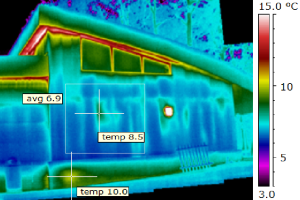What is thermal imaging, also known as infrared thermography?
Thermography is a name for a type of photography which is based on infrared wavelengths (as opposed to visible wavelengths). Conventional photography relies on reflected energy from a light source, be it the sun or artificial lighting, which is visible to our eyes. In contrast, thermal imaging relies on radiated energy in the infrared (IR) spectrum which is invisible to our eyes. All objects emit radiation energy within the IR spectrum. This IR radiation varies dependent on the temperature of that object’s surface.
If we could see this radiation, we could “see” the temperature of the surface of an object. As we cannot do this with our eyes, we need to use a device which can detect the “invisible” energy. A thermal imaging camera can do this. The camera builds a pixelated image of the IR radiation which allows us to “see” and measure the apparent temperature of the surface.
What is Thermal Imaging Used for in Buildings?
Visualising the surface temperatures of a building helps the thermographer to decipher many things about it. The building thermographer can decide what can be inferred from a thermal image based on a knowledge of the environmental conditions at the time. The thermographer also needs to know about construction techniques and materials, as well as building physics.
Armed with this information, visualising the surface temperatures gives us information about insulation, thermal bridging and other aspects of building heat loss.
What Else Can we Use Thermography for in Buildings?
We can do much more than just look at heat loss. As surfaces or objects which contain moisture behave differently to otherwise similar “dry” surfaces and objects, the presence of moisture can often be visualised by different thermographic techniques. When used in conjunction with other diagnostic tools to confirm the suspected damp areas, leak migration paths can often be traced back to the source.
What are the Benefits of Thermography?
Thermography is non-invasive, non-contact and hence non-destructive. It can be used to scan large areas quickly and identify anomalies such as defective insulation or potential areas of dampness and trace and record paths in a way that other methods cannot.

Building thermography is often a qualitative methodology. That is to say we look at patterns and comparison rather than absolute temperatures. Therefore, thermal images are often used with the temperature scale removed. In this case, the absolute temperatures are not important but anomalies, patterns and relative temperatures are.
ScanTherm normally uses a high contrast “rainbow” scale or “palette”. The scale shows relatively cold (black/purple/blue) to relatively hot (yellow/red/white), but the values will vary from image to image. If absolute temperatures are required they will be indicated. An example thermal image is shown for reference above.
